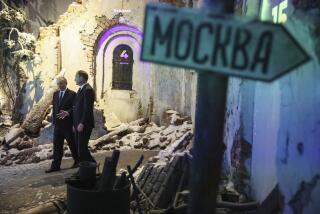Another Chernobyl ‘Not Possible,’ Soviets Assert
- Share via
VIENNA — The nuclear authorities of 47 countries Friday ended a review of the Chernobyl reactor disaster on a note of optimism, as Soviet officials declared that a similar accident could never happen again, and Western experts maintained that their safety systems and procedures are in crucial ways superior.
“A similar accident is not possible anywhere in the world,” said Valery A. Legasov, the head of the Soviet delegation at the closing session of the five-day conference, which was organized by the International Atomic Energy Agency.
Legasov added, however, that “this does not mean that all experts on nuclear energy should not review their systems twice, three times over, and continue to study the Chernobyl accident.”
Detailed Soviet Explanations
American, British and a number of other Western officials appeared to draw comfort from detailed technical explanations the Soviets provided, which demonstrated the roles that unique design features of the Soviet graphite reactor played in the April 26 accident.
“I don’t see a lot of relevance to American systems, or to our safety philosophy,” Harold H. Denton, the director of reactor regulation at the U.S. Nuclear Regulatory Commission, told reporters later.
If anything, Denton said, the explosion and fire in the Chernobyl reactor’s combustible graphite core, which released an estimated 50 million curies of radioactive wastes into the atmosphere, reaffirmed the importance of enclosing large nuclear power plants in massive steel and concrete containment structures, which the Chernobyl reactor and 14 similar Soviet units lack.
‘The Value of Containment’
“This accident does show the value of containment,” Denton said. “I feel that if this plant had a U.S.-style containment, it would have been very effective.”
Although a series of operator errors triggered the accident, the Soviets made clear that design flaws--chiefly a tendency for the nuclear chain reaction to race out of control under some conditions--amplified their errors into a catastrophic accident.
Both the Soviets, who did most of the talking, and Western experts expressed satisfaction that the basic purpose of the meeting--an exchange of information and theories about the causes and consequences of the accident--had been accomplished.
Richard T. Kennedy, the U.S. delegation chief and ambassador at large for nuclear affairs, joined other Westerners in praising the Soviets for their candor and cooperation in providing a wealth of detail about the accident.
“We largely received what we came for and heard more than we probably expected,” Kennedy said.
Solidarity, Not Criticism
Legasov, Kennedy’s Soviet counterpart, spoke similarly of an atmosphere of “solidarity rather than criticism” at this gathering of the world nuclear community.
The conference produced no formal conclusions, but there was general agreement about the causes of the accident--the combination of human error and design flaws--and the appropriateness of several quick technical fixes the Soviets are making to reduce the sensitivity of their graphite reactors to similar human errors. Whether these modifications will prove sufficient remains an open question, however.
“The changes are moving in the right direction,” Denton of the U.S. Nuclear Regulatory Commission said. “As for whether they are fully satisfactory, we don’t know. We’re still assimilating a lot of information.”
A week of technical discussions with the Soviets drew the human and mechanical causes of the accident into sharper focus and began a debate over the potential long-term health effects, inside the Soviet Union and beyond its borders, that may never be resolved.
Accident’s Course Traced
The accident began, the Soviets made clear, not only with errors by the operating crew but with a series of deliberate violations of written procedures as operators rushed to complete a safety test that was both minor and unauthorized.
This negligence, Legasov said, seemed to be rooted in complacency. Ironically, the Chernobyl plant had the best record for reliability of any of the 15 such units in the Soviet Union.
Moreover, the operators’ ability to recognize and cope with a developing accident was handicapped, the Soviets said, by training programs that had provided little chance to work with a computerized simulator.
U.S. officials noted that before the Three Mile Island nuclear plant accident in 1979, U.S. operators also spent little time training on simulators.
“Now you see them at almost every plant,” the NRC’s Denton said.
Crucial Design Error
The ability of Soviet operators to switch off emergency shutdown systems was a crucial design error and is to be eliminated. But the Soviets found that the accident itself--a self-feeding burst of nuclear energy called a power excursion--proceeded far too fast for human reflexes or for existing control rod systems to stop.
The Soviets said this may require a new emergency system to automatically and instantaneously inject neutron-absorbing gases or liquids into the reactor at high speed to kill the chain reaction in an impending emergency.
More to Read
Sign up for Essential California
The most important California stories and recommendations in your inbox every morning.
You may occasionally receive promotional content from the Los Angeles Times.













